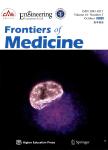Nicotine gum or patch treatment for smoking cessation and smoking reduction: a multi-centre study in Chinese physicians
Nicotine gum or patch treatment for smoking cessation and smoking reduction: a multi-centre study in Chinese physicians作者机构:Beijing Chao-Yang Hospital Capital Medical University WHO Collaborating Center for Tobacco or Health Beijing 100020 China Beijing Institute of Respiratory Medicine Beij'ing 100020 China Department of Respiratory Capital Medical University Beijing 100069 China Guangzhou Institute of Respiratory Disease 1st Affiliated Hospital Guangzhou Medical College Guangzhou 520120 China Zhongshan Hospital Fudan University Shanghai 200032 China Changzheng Hospital 2nd Military Medical University Shanghai 200003 China 1st Affiliated Hospital Sun Yat-sen University Guangzhou 510080 China people's Hospital Peking University Beijing 100044 China Shanghai Johnson & Johnson Pharmaceuticals Shanghai 200245 China McNeil AB Helsingborg Sweden Johnson & Johnson New Jersey USA Research Centre of Respiratory Medicine in Beijing Hospital Ministry of Health of the People 1's Republic of China Beijing 100730 China
出 版 物:《Frontiers of Medicine》 (医学前沿(英文版))
年 卷 期:2014年第8卷第1期
页 面:84-90页
核心收录:
学科分类:08[工学] 0822[工学-轻工技术与工程] 082202[工学-制糖工程]
基 金:Shanghai Johnson & Johnson Pharmaceuticals Ltd
主 题:nicotine replacement therapy smoking cessation Chinese physicians
摘 要:In China, around 23% of physicians (41% male, 3% female) currently smoke. Pharmacotherapy for tobacco dependence is available, but is not widely used in China. The purpose of this study was to estimate the effectiveness and the safety on smoking cessation of nicotine gum and nicotine patch in Chinese healthcare professionals. Three hundred regular smokers motivated to quit were recruited from six hospitals in China. All subjects were accepted nicotine replacement therapy, and they could choose nicotine gum (2 mg or 4 mg, depending on baseline smoking level) or nicotine patch (15 mg/16 h) for 12 weeks, with a 12-week follow-up. Limited behavioural support was provided. At Week 24, the 2-24 weeks continuous abstinence rate (verified by expired carbon monoxide) was 17%, the point prevalence abstinence rate (no smoking since the previous visit) was 35%, and 38% of subjects had continuously reduced their daily cigarette consumption by at least 50% versus baseline. Compliance with treatment was good, particularly with patch. No serious adverse event was reported, and most adverse events were mild or moderate. The most common treatment-related adverse events were gastro- intestinal (both gum and patch) and local irritation symptoms. Nicotine patch and gum were well tolerated in Chinese smokers. Abstinence rates were comparable to those previously reported with nicotine replacement therapy, and many smokers who did not quit substantially reduced their cigarette consumption.




